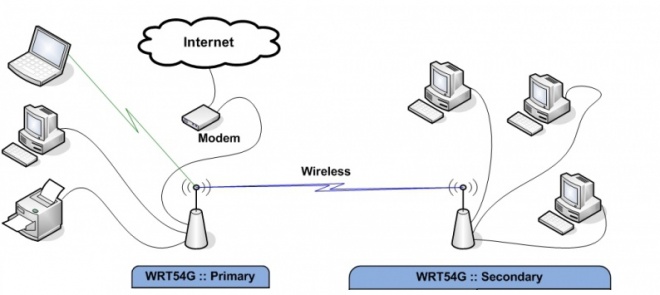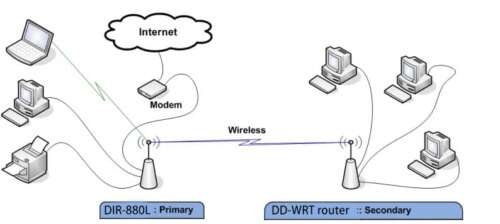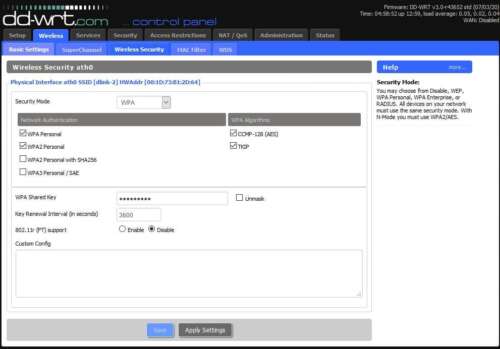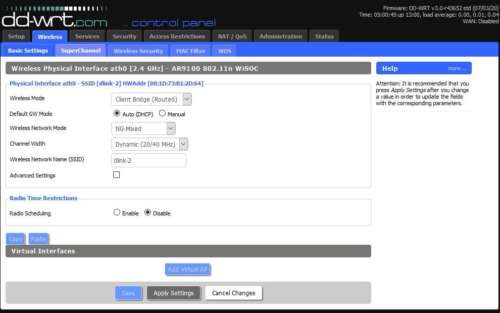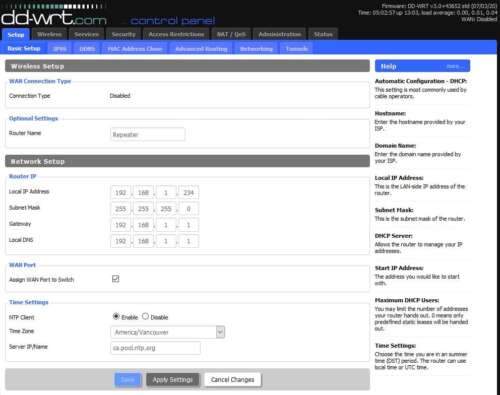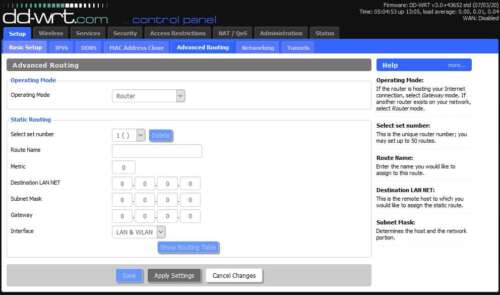From DD-WRT Wiki
Jump to: navigation, search
Wiki Path: DD-WRT Wiki Main / Tutorials / Linking Routers / Client Mode
The secondary (client) router is unbridged in a different subnet (with NAT), while a Client Bridge is the same subnet as the host.
Contents
- 1 Introduction
- 2 Client (Station) Mode Setup
- 3 Client Restrictions
- 4 Troubleshooting
[edit] Introduction
This mode is NOT for WIRED connections between two routers, like an Access Point. It is a wireless connection between two routers only, usually to the primary gateway router. A Client Mode router connects to a Wireless Access Point (WAP) wireless connection as the WAN interface, and shares the internet connection only to the LAN ports, or a separate WAP for multi-radio routers. It is not seen as a WAP, nor accepts wireless connections by other client devices.
The primary (host) router is not required to be running DD-WRT firmware. The primary and secondary (DD-WRT Client Mode) routers must be on separate subnets, and NAT is used between them. Thus, when port forwarding is needed it must be configured at both routers — not just on the host router.
A Client Mode router uses its own DHCP server for IP Address, Gateway, and DNS server to connected devices. To have computers connected to both routers (main and secondary) and co-exist in the same subnet, set up DD-WRT as a Client Bridge, Repeater Bridge or use WDS. Further explanation of bridging modes is at Linking Routers.
- If using a multi-band router, do not set more than one band to CB. The other radio(s) would normally be set as AP. For example, the 2.4GHz radio can a CB while the 5GHz is an AP, or vice versa.
[edit] Client (Station) Mode Setup
The secondary client router will be on a different subnet than the primary host router. For example, if the host router IP address is 192.168.1.1, configure the client router to 192.168.2.1.
- These instructions assume a reset router. Broadcom routers: read the Peacock thread
- Connect a cable from your computer to the LAN port on your router.
- (Optional) Set your computer to a static IP address (e.g. 192.168.1.7, subnet 255.255.255.0)
- Connect to the DD-WRT GUI at 192.168.1.1 in a browser
- Set a username and password — if not asked for this, do a proper reset!
- Go to Wireless: these settings must match the primary host router — Check spelling and case!
- In Wireless->Basic Settings and change the Wireless Mode to «Client»
- Set the Wireless Network Name (SSID) to exactly match the primary router. Click Save (not Apply)
- If multiple routers broadcast the same SSID, to connect to a specific one (i.e. the primary router, instead of a repeater), enable MAC Filtering on the Wireless Tab, and add the specific device’s MAC Address.
- MAC Address can be found on the «Site Survey» page, linked from the Wireless tab in Status
- Wireless Security: set the Security Mode and other information same as primary router. Click Save (not Apply)
- (Optional) If available, in Wireless tab (or under Advanced), set (or disable) the Ack Timing in meters
- Go to Setup->Basic Setup: if needed, change Connection Type to Static IP from «Automatic Configuration — DHCP»
- Static IP allows easier access remote GUI, SSH, or telnet access is enabled under Administration
- If the client router requires external management, go to Setup->Basic Setup, set the WAN port protocol as needed and enter info provided by your ISP. This is the setting that is bonded to the wireless interface.
- In Network Setup set the Local IP Address to a different subnet from the primary host router (e.g. 192.168.2.1)
- Set the Gateway address to the primary host router gateway or internet will not work (e.g. 192.168.1.1)
- The device should be in GATEWAY Advanced Routing mode, not ROUTER, or Masquerade/NAT does not happen.
- (Optional) Set your local DNS to the IP address of your client router
- (Optional) Set Static DNS servers in Network Address Server Settings (DHCP) if not provided or wanted from WAN
- (Recommended) Change the Time Zone and DST settings as needed.
- (Optional) Set a «Server IP/Name» in Time Setting section for NTP (blank uses a default server)
- Click Save (not Apply)
- (Optional) In Security->Firewall, disable SPI Firewall if security between AP & Client is not needed
- Click Apply, then change the computer back to auto IP/DNS if needed (replug the LAN cable if not working)
- Let the client router reboot and connect to the host, then configure on the new Client IP address as needed
- If not working, unplug the router for 30sec and retry
[edit] Client Restrictions
To allow internet access but prevent 192.168.1.x clients from seeing each other on br0, use this firewall script (iptables):
iptables -I FORWARD -i br0 -d 192.168.1.0/24 -j DROP
[edit] Troubleshooting
If the preceding instructions do not work, it is usually an encryption or password problem. Disable encryption on the primary router and retry the setup. Using proper encryption and the correct case-sensitive password is key. Do a reset and start over. Note: WPA2-AES (aka CCMP) is required for 802.11N (and newer) devices.
by kczon.com
DD-WRT firmware supports Wireless Client Mode which enable your router into fully capableWireless Adapter. Client mode is just wireless connection between two routers. You can connect your router to the another Wireless Network or to the Hotspot. You can also share your android phone data connection to your home network on multiple devices which are not capable to connect via wi-fi.
Normally I used Client Mode on DD-WRT when my ISP shutdown for some days. I could connect my android device to my home network and share 3G connection to the multiple PC which are connected to the router via LAN port.
Here I’m going to show you today, how to set up Client Mode on DD-WRT Router in simple steps!, It is a quite simple method that by change Wireless Mode of your DD-WRT Router.
How to Use DD-WRT Router as Wireless Adapter – Client Mode
Here, Primary Router is Source Router or Main Router.
You need to go first
1. Wireless > Basic Settings > Wireless Physical Interface
Change Wireless Mode to the Client Mode.
2. On the Same tab > Set all these following options exactly the same as your primary router
- Wireless Network Mode
- Wireless Network Name (SSID)
- Wireless Channel
- Channel Width
- Extension Channel
3. Now navigate to the Wireless Security on the same Wireless tab.
Set all these following options exactly the same as your primary router
- Security Mode
- WPA Algorithms
- WPA Shared Key
4. Now navigate to the Setup > Basic Setup > WAN Setup > WAN Connection Type
Set Connection Type to the Automatic Configuration – DHCP
5. On the Same tab in the Network Setup > Router IP
Set the Local IP Address to 192.168.2.1 (Your Client subnet must differ from the Primary Router subnet).
6. Now navigate to the Advanced Routing on the same Setup tab.
Change Operating Mode to the Gateway Mode instead of Router Mode.
7. Apply all Settings and Reboot the Router.
Now you can able to use DD-WRT Router as Wireless Adapter.
I have a main (primary) router with the Internet connection in the living room. And I have two devices in the basement. How I make them connect to the Internet is a problem.
Here I use secondary router wireless connect to the primary router. And two devices wired to connect to the secondary router.
I don’t need wireless connections to the Secondary router. I also want to make all these devices in the same sub-network. So I choose Client Bridge mode.
Based on the wiki page from DD-WRT.
Only use this or Repeater Bridge mode if all of the others are unsuitable: WDS, Client, Repeater, or AP.
Client Bridge will never be as stable as any of those modes. It is by design a hack and not a true transparent bridge like WDS. It will cause connection problems for more than a single client. See Linking Routers for a description of each of the modes.
Client Bridge (CB) extends a wired LAN using a wireless connection, as opposed to an Access Point that extends the Wireless LAN (WLAN) using a wired connection. CB is a wireless connection (NOT wired) between two routers only. All devices connections, besides the primary router, MUST be wired to the CB router.
CB is the last choice for me.
Here is my basic information.
Computer: Acer AspireOne ZG5, Windows XP, NIC set to auto retrieve the IP address.
Primary Router: D-Link DIR-880L, Hardware version A2, Firmware v1.20, Regular settings.
Router LAN IP: 192.168.1.1, DHCP range to 192.168.1.199.
Wireless: 2.4GHz SSID: dlink-2, 802.11 g/n, Channel width: Auto 20/40 MHz
Secondary Router: Buffalo WZR-HP G300NH, DD-WRT firmware v3.0-r43652 std (07/03/20)
How to config the Secondary Router?
Most important is the setup for the Secondary router. Before I start, do the HARD reset on it.
- Connect a cable from my computer to the LAN port just next to the WAN port on my router.
- Set my browser to 192.168.11.1, and open the dd-wrt GUI. (Because the dd-wrt on Buffalo use 192.168.11.1 as the router IP.)
- If asked for the password and username, just follow the guide to change it.
- Go to the Setup >> Basic Setup, change Local IP Adress to 192.168.1.1, SAVE and Apply. Restart the Router.
- Set my browser to 192.168.1.1, and open the dd-wrt GUI.
- FIRST, go to Wireless->Wireless Security and set the security type and key (dlink-2) from the primary router.
- Click SAVE, and then APPLY.
- Go to the Wireless->Basic Settings page and change the wireless mode to Client Bridge(Routed).
- The wireless network mode (NG-Mixed), channel (Dynamic(20/40 MHz), and encryption match the primary router settings.
- Set the wireless network name exactly the same as your primary router.
- Click SAVE, and then APPLY.
- Go to Setup->Basic Setup and enter a router Local IP address e.g. 192.168.1.234 because my primary router is on that subnet. Client Bridge subnet must match the primary router. The subnet mask is usually 255.255.255.0.
- Set the Gateway IP to your primary router, usually 192.168.1.1
- Set the Local DNS to 192.168.1.1
- Check Assign Wan port to a switch
- Set the Timezone and DST appropriately (America/Vancouver, ca.pool.ntp.org)
- Click SAVE, and then APPLY.
- Go to the new Client Bridge IP address in the browser e.g. 192.168.1.234
- Go to Security->Firewall: under Block Wan Requests uncheck all but “Filter Multicast”
- Disable SPI Firewall
- Click Save, and then Apply.
- Go to Setup->Advanced Routing: change the Operating Mode from Gateway to Router.
- Click SAVE, and then APPLY
- Reboot the router.
Here are some screenshots:
PS:
About my two devices connected to the Secondary Router. They don’t have wireless parts, and I want to use them in the basement. One is the MagicJack VOIP device. The other one is the Proxmox VE machine, which hosted five VMs.
Для многих пользователей сети DD-WRT это не просто обычный маршрутизатор, но и мощный инструмент, который позволяет настроить сеть в соответствии со своими нуждами. Одной из самых полезных функций DD-WRT является возможность использовать его в режиме WiFi клиента. Это позволяет подключить ваш маршрутизатор к существующей беспроводной сети и использовать его как точку доступа для других устройств.
Но настройка DD-WRT в режиме WiFi клиента может показаться сложной задачей для пользователей без опыта в работе с сетевыми устройствами. В этой статье мы предоставим вам пошаговую инструкцию о том, как настроить DD-WRT в режиме WiFi клиента, чтобы вы могли использовать его в своей сети.
Содержание
- Шаг 1: Подключение к интерфейсу управления DD-WRT
- Шаг 2: Настройка режима WiFi клиента
- Шаг 3: Проверка настроек и тестирование соединения
- Подготовка оборудования
- Подключение к DD-WRT
- Настройка беспроводного соединения
- Установка IP-адреса для режима клиента
- Настройка шифрования
- Проверка соединения
Прежде чем начать настраивать DD-WRT, вам нужно подключиться к его интерфейсу управления. Для этого откройте веб-браузер и введите IP-адрес вашего маршрутизатора в адресной строке. Обычно это 192.168.1.1 или 192.168.0.1. Если вы не уверены в IP-адресе вашего маршрутизатора, вы можете найти его в настройках вашей основной беспроводной сети.
После ввода IP-адреса, нажмите Enter, и вы должны увидеть страницу входа в интерфейс управления DD-WRT. Введите свои учетные данные, если они есть, и нажмите кнопку «Войти». Если вы никогда не вносили изменений в настройки DD-WRT, учетные данные по умолчанию могут быть admin/admin или root/admin.
Шаг 2: Настройка режима WiFi клиента
После входа в интерфейс управления DD-WRT перейдите на вкладку «Wireless». Здесь вы найдете различные настройки беспроводной сети. Для настройки режима WiFi клиента выберите режим «Client» или «Client Bridge» в списке режимов, в зависимости от вашего маршрутизатора.
Затем выберите сеть, к которой вы хотите подключиться, в списке доступных сетей. Введите пароль для этой сети и нажмите кнопку «Применить». DD-WRT попытается подключиться к выбранной сети и установить соединение как WiFi клиент.
Шаг 3: Проверка настроек и тестирование соединения
После настройки режима WiFi клиента перейдите на вкладку «Status». Здесь вы должны увидеть информацию о вашем новом подключении. Проверьте, что у вас есть IP-адрес и соединение сети. Если информация отображается правильно, значит ваш маршрутизатор успешно подключен в режиме WiFi клиента.
Теперь вы можете подключить другие устройства к вашему маршрутизатору и использовать его как точку доступа в вашей сети. Убедитесь, что другие устройства могут подключиться к вашей сети без проблем и наслаждайтесь лучшей производительностью вашей сети с помощью настроенного DD-WRT в режиме WiFi клиента.
Подготовка оборудования
Перед тем, как начать настраивать DD-WRT в режиме WiFi клиента, убедитесь, что у вас есть следующее оборудование:
- Маршрутизатор DD-WRT: Убедитесь, что ваш маршрутизатор поддерживает прошивку DD-WRT и вы уже установили ее. Если вы не уверены, проверьте список поддерживаемых моделей на официальном сайте DD-WRT.
- Компьютер или ноутбук: Вам понадобится компьютер или ноутбук для настройки и управления маршрутизатором DD-WRT. Убедитесь, что у вас есть доступ к интернету через этот компьютер или ноутбук.
- Wi-Fi сеть: Вам понадобится рабочая Wi-Fi сеть, к которой вы хотите подключиться в режиме клиента. Убедитесь, что у вас есть доступ к Wi-Fi сети и вы знаете ее имя (SSID) и пароль.
После того, как вы убедились, что у вас есть все необходимое оборудование, вы можете переходить к следующему шагу настройки DD-WRT в режиме WiFi клиента.
Подключение к DD-WRT
Перед началом настройки DD-WRT в режиме WiFi клиента, убедитесь, что у вас есть доступ к интерфейсу маршрутизатора DD-WRT. Для этого выполните следующие шаги:
Шаг 1: Подключите компьютер к маршрутизатору DD-WRT с помощью Ethernet-кабеля.
Шаг 2: Откройте любой веб-браузер и введите IP-адрес маршрутизатора в адресной строке. Обычно IP-адрес DD-WRT 192.168.1.1, но это могло быть изменено вашим провайдером.
Шаг 3: Введите логин и пароль для доступа к интерфейсу DD-WRT. Если вы не меняли эти данные, то логин по умолчанию — «admin», а пароль — «password».
Шаг 4: Нажмите кнопку «Войти» или «Login».
Шаг 5: Если данные для входа в систему были введены правильно, вы будете перенаправлены на главную страницу интерфейса DD-WRT.
После успешного подключения к DD-WRT вы можете приступить к настройке его в режиме WiFi клиента.
Настройка беспроводного соединения
Для настройки беспроводного соединения в режиме WiFi клиента на DD-WRT, выполните следующие шаги:
- Войдите в панель администратора вашего роутера DD-WRT, открыв веб-браузер и введя IP-адрес вашего роутера.
- В меню DD-WRT найдите раздел «Wireless» и перейдите в него.
- На странице настройки беспроводного соединения, найдите раздел «Wireless Mode» и выберите значение «Client» или «Client Bridge».
- Укажите SSID (название беспроводной сети) и пароль существующей беспроводной сети, к которой хотите подключиться.
- Настройте безопасность соединения, выбрав соответствующие значения для полей «Security Mode» и «WPA Algorithms».
- Сохраните изменения, нажав кнопку «Save» или «Apply».
После сохранения настроек ваш роутер DD-WRT будет работать в режиме WiFi клиента и подключаться к выбранной беспроводной сети. Вы сможете использовать его для распределения сети по проводным устройствам.
Установка IP-адреса для режима клиента
Чтобы настроить IP-адрес для режима клиента, выполните следующие действия:
| Шаг | Описание |
|---|---|
| 1 | Войдите в веб-интерфейс маршрутизатора DD-WRT, введя его IP-адрес в адресной строке браузера. |
| 2 | Введите свои учетные данные для входа в систему (логин и пароль). |
| 3 | После успешного входа в систему найдите и щелкните по вкладке «Настройки». |
| 4 | В выпадающем меню выберите «Основные настройки». |
| 5 | Прокрутите страницу вниз до раздела «IP-адрес». |
| 6 | Выберите опцию «Статический IP-адрес». |
| 7 | Введите новый IP-адрес для маршрутизатора в соответствующее поле. |
| 8 | Введите подсеть и шлюз по умолчанию в соответствующие поля, если требуется. |
| 9 | Сохраните изменения, нажав кнопку «Применить». |
| 10 | Перезагрузите маршрутизатор, чтобы применить новую конфигурацию IP-адреса. |
После перезагрузки маршрутизатора новый IP-адрес будет использоваться для режима клиента, и вы сможете подключиться к новой сети через маршрутизатор DD-WRT.
Настройка шифрования
После установки подключения к беспроводной сети вам нужно настроить шифрование, чтобы защитить свои данные от несанкционированного доступа.
1. Зайдите в веб-интерфейс DD-WRT, введя IP-адрес вашего роутера в адресную строку браузера и нажмите Enter.
2. Войдите в раздел Wireless, затем выберите вкладку Wireless Security.
3. В поле Security Mode выберите способ шифрования, например, WPA Personal.
4. В поле WPA Algorithms выберите соответствующий алгоритм шифрования, например, AES.
5. В поле WPA Shared Key введите ключ шифрования. Помните, что этот ключ должен быть сложным и надежным.
6. Нажмите кнопку Save, чтобы сохранить ваши настройки.
Теперь ваш роутер DD-WRT настроен на использование шифрования и защиты вашей сети Wi-Fi. Убедитесь, что вы помните ваш ключ шифрования, так как он потребуется при подключении к сети.
Проверка соединения
После настройки DD-WRT в режиме WiFi клиента вам следует проверить соединение, чтобы убедиться, что все работает должным образом. Вот несколько шагов для проверки соединения:
- Подключите ваше устройство (например, компьютер) к DD-WRT по LAN-кабелю.
- Убедитесь, что устройство получает IP-адрес от вашего основного роутера или точки доступа. Можно проверить IP-адрес, открыв командную строку (консоль) и введя команду «ipconfig» (для Windows) или «ifconfig» (для Linux/Mac).
- Попробуйте открыть веб-браузер и убедитесь, что вы можете получить доступ к Интернету. Попробуйте открыть несколько различных веб-сайтов, чтобы убедиться, что соединение стабильно и работает нормально.
- Если у вас есть проблемы с соединением, попробуйте перезагрузить роутер, ваше устройство и основной роутер или точку доступа. После перезагрузки проверьте соединение еще раз.
Если все шаги выполнены успешно и вы можете получить доступ к Интернету, то ваш DD-WRT настроен в режиме WiFi клиента и готов к использованию с вашим основным роутером или точкой доступа.
Режим Client Bridged позволяет настроить ddwrt-роутер на приём (а не на раздачу) интернета через wifi (например, от другого роутера). Таким образом, ваш роутер можно заставить работать, будто бы он просто беспроводной адаптер.
Основные настройки:
- Wireless — Mode — Client Bridge
- WAN Connection Type — Disabled
- Указать SSID раздающего роутера, ключи безопасности и пр.
- Нажать Site_Survey, выбрать свою первую wifi сеть — нажать Join
- DHCP Server — Disabled (временно для доступа к web конфигуратору на компе выставляем ручной айпи — 192.168.1.10)
Network Setup:
- IP этого второго роутера должен быть в подсети первого роутера — 192.168.1.2
- Gateway (IP первого роутера) — 192.168.1.1
- Галочку на WAN Port — Assign WAN Port to Switch
- Advanced Routing — Operating Mode — Routing.
- Dynamic Routing— Interface — Disabled
- Security — Firewall — Сначала при включённом SPI Firewall, выключить все галочки кроме «Filter Multicast«, применить сохранить. Потом отключить и SPI Firewall. Применить , сохранить.
вернуть на компе настройки на автоматическое получение IP.
Первый роутер — раздающий инет. Второй — ddwrt-шный, получающий. Копаемся, естественно, в настройках второго.
